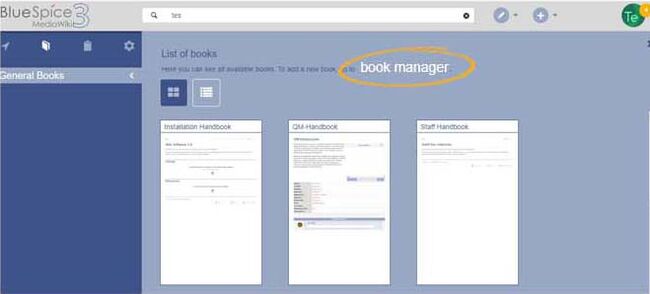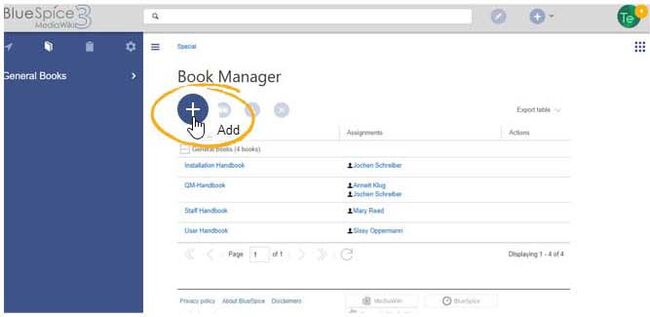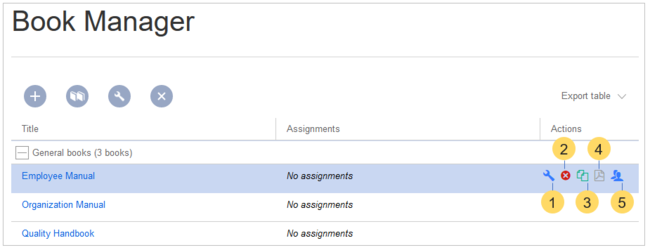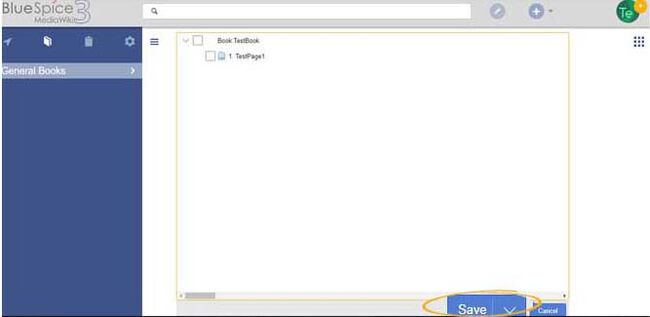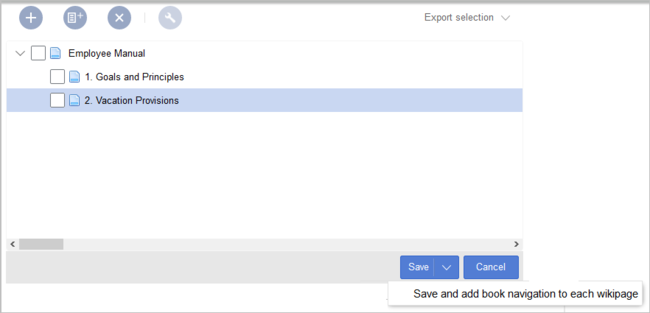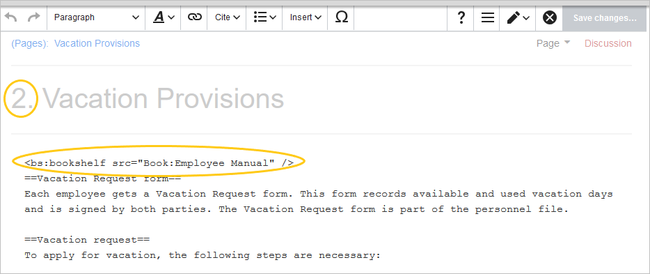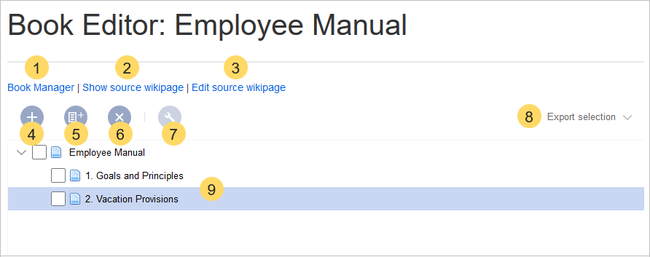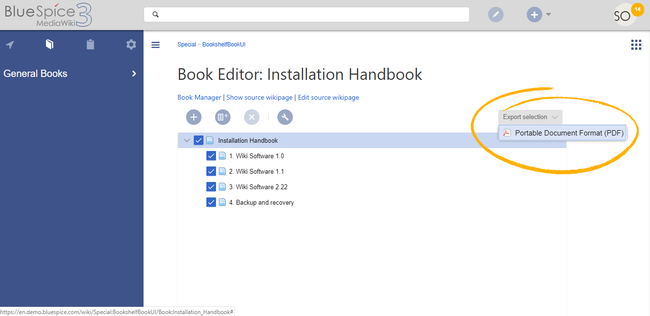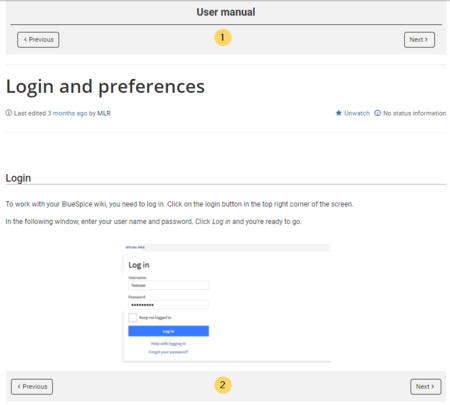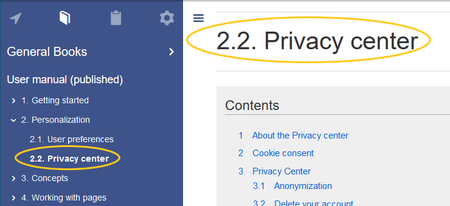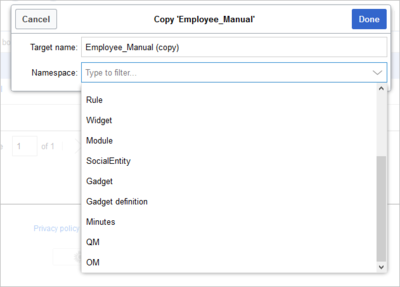Books
-
- Last edited 5 years ago by MLR
-
-
- No status information
The extensions Bookshelf and BookshelfUI expand the BlueSpice distribution, combining wiki pages into a structured book with chapter navigation. These books can also be printed as a PDF file with a cover page and a clickable table of contents
Contents
Characteristics of books
With BlueSpice Pro, you can assemble individual wiki pages into a book. In a book, you can read through a collection of pages in a linear fashion by moving through the book navigation. This is useful if you have lots of related pages that should be read in a particular order. And it makes it easy to write documentation and to comply with your documentation standards. All the books that are available on the wiki are accessible through the left navigation menu, tab "Books" with the book icon. Books are displayed as list or grid view. Clicking on a book opens the selected book. Once the book is opened, its chapter navigation appears in the left navigation.
Book manager
The menu item Global Actions > Book manager loads the page Special:BookshelfBookManager. Here, you can add a new book by clicking the plus button.
You can take the following actions on a book:
- Editing a book (1): Links to the Book editor where you can edit the book contents and metadata.
- Deleting a book (2): Deletes the book page in the namespace Book without deleting the wiki pages.
- Duplicating a book (3): Duplicates this book, including all the pages of the book.
- Export (4): Exports the wiki pages in this book to PDF.
- Assign (5): Assigns the book to designated users.
Creating a book
To create a book:
- Go to Global actions > Book manager.
- Select the Create (+) button.
- Enter a Book title and the Type of the book:
- General books: Visible to all users. It should have a book navigation.
- Own books: Books only visible to me.
- Click Done.
General books
General books are visible to all users and are usually characterized by their additionally generated book navigation.
Own books
Own books are only visible in the book list to the book creator. You cannot create chapter navigation in the navigation bar for your own books. However, like general books, your own books can be exported as a PDF with a title page.
Temporary books
This selection is available to wiki users who are logged in or not logged into the wiki. These books are only temporarily stored in the user's browser and not in the wiki itself. If the browser cache is deleted or the user switches to another browser, the book is no longer available. The main aim of temporary books is to enable users to print out a book as a PDF.
A chapter navigation cannot, therefore, be created for temporary books.
The book editor
After that, the book editor opens. Here you can add pages to your book by clicking the plus button. A dialog opens, where you can select the pages you want to add to your book.You can also enter the name of a page that doesn't yet exist.
Mass-adding pages
After clicking "Mass add", a dialog is opened. It contains different criteria for page selection:
- All pages of a category
- All subpages of a certain page
- From a page collection - page collections are lists of pages located in the MediaWiki namespace. They are usually created from search results.
- By a semantic property - pages can be selected based on the value of a certain semantic property.
After adding your book pages click Save at the bottom of the page. Now you have created a page in the namespace Book. It contains the list of pages that have been added to the book.
After saving a book page, you have created a wiki page in the namespace Book which contains a list of links to the wiki pages in the book. The chapter navigation is generated separately.
To add the chapter navigation, go back to the book page in the book manager. Clicking on the book title opens the book page in the book editor. Scroll down to the Save button and select the drop-down arrow. Click Save and add book navigation to each wiki page.
This adds a bookshelf tag in the source code of all wiki pages that are part of this book. The tag, therefore, defines which book this page belongs to: <bookshelf src="Book:EmployeeManual" />.
Note: If you later add more pages to a book, you have to generate the chapter navigation again. Without this step, the newly added pages will not have a bookshelf tag and therefore not be shown in the chapter navigation of the book. If you only added one or two new pages, you can also add the bookshelf tag manually to the source code of these new pages.
Important! Each wiki page can only be added to one book. If a page later is added to another book with chapter navigation, the page always leads to the chapter navigation of the book that last generated or updated its chapter navigation.
Editing a book
After you have created the book, click on the name of the book. This opens the Book Editor.
Editing a book is is similar to creating a new book regarding adding pages to the book. Pages can also be removed from a book by right-clicking on the page name and selecting Delete from book (this will not delete the wiki page itself). Chapters - and the general book structure - can be re-arranged by dragging and dropping pages in the book structure. By dragging and dropping Page A over Page B, Page A will be placed underneath Page B in the book hierarchy.
- Book Manager (1): Link to the main Book manager page (only up to v3.1).
- Show source wikipage (2): Opens the book navigation page in view mode (only up to v3.1)..
- Edit source wikipage (3): Opens the book navigation page in edit mode (only up to v3.1)..
- Add page (4): Button for adding a page.
- Mass-add pages (5): Button for adding a set of pages (by category, subpages of a page, page collection, or semantic property).
- Remove page (6): Removes the selected pages.
- Manage metadata (7): Add or remove metadata.
- Export selection (8): Exports the selected pages to a PDF file.
- Book contents (9): Shows all pages in the book hierarchy Pages can be arranged by drag-and-drop. A multi-level organization is possible.
Inserting meta data
While editing a book (adding or removing pages), meta-data for the book can be added. To edit metadata, select top-most node of the book (first page) and click the wrench icon. A dialog will be opened where various meta-data can be added or removed. Some of the most important meta-data include:
- Title
- Subtitle
- Author 1 and 2
- Document-ID
- Document type
- Department
- Version
- Template (PDF)
- Table of Contents (Only article titles, or Embed article TOCs)
Adding a cover image
To add a cover photo for the book, add a metadata item Bookshelf image. Select this option from the dropdown and click Add. Once the meta data is added enter the name of the image in the value field. Any image currently uploaded to the wiki can be used. Type the name without the "File:" prefix (enter the image name and file extension).
Exporting books
You can export an entire book, individual chapters or single pages as PDF:
- Open the book in the book editor.
- Select all pages or chapters you want to export by clicking the associated checkboxes. Subchapters will be automatically selected.
- Clicking on the "Export selection" dropdown menu opens a list of availble formats. By clicking on one of the formats offered the book export starts.
Configuration
Display options
- Show book chapter pager after content: Displays previous/next book page navigation at the end of each book page. (1)
- Show book chapter pager before content: Displays previous/next book page navigation at the beginning of each book page. (2)
- Use the display title from book source on article: Shows the title from the book navigation as page title instead of the page name.
Note: If the page additionally contains a {{DISPLAYTITLE}} tag, the display title of the page is shown instead of the book title.
- Prepend article table of contents and headlines with book numberation
- Supress namespace prefix of book articles in output
Export options
Extension:DynamicPageList (DPL), version 3.3.2: Warning: No results.
Configuring the file size limits (server)
By default, the book export is limited to 50MB in file size. To adjust this value, complete the following steps:
- In Apache Tomcat, open the file web.xml:
sudo -s nano /opt/tomcat/webapps/manager/WEB-INF/web.xml
- Look for the following lines and adjust the value (e.g. for 250MB=26214400)
<max-file-size>262144000</max-file-size> <max-request-size>262144000</max-request-size>
- The web app BShtml2PDF also has a setting that needs to be adjusted:
nano /opt/tomcat/webapps/BShtml2PDF/WEB-INF
- Enter your values in the following lines:
<param-name>maxMemSize</param-name> <param-value>26214400</param-value> <param-name>maxFileize</param-name> <param-value>26214400</param-value>
- Apache Tomcat neu starten
service tomcat restart
Deleting a book
When you delete a book, you only remove the book page in the namespace Book from the Book manager. The wiki pages in the book, however, are not deleted. Before you delete the book, you are informed in a pop-up menu that the bookshelf tag is not automatically removed from the pages:
The bookshelf tags have no effect on the wiki pages after deleting the book. If you want to remove them manually, you can go to the page Special:ReplaceText and do a find and replace to delete the booktag from the pages.
Duplicating a book
You can create an entire copy of the book by duplicating it:
To duplicate a book:
- Enter a target name: The default vlaue is the book name with the suffix (copy). Change this to create a different book title.
- Select a namespace: Choose a namespace that is different from the original namespace.
If you are not careful, you might experience some unintended consequences. By creating a new book, you also create copies of all the wiki pages in the original book. Since a namespace cannot contain the same page twice, you have to copy the files to a different namespace.
About the duplicated files:
- Book page: A new page in the namespace book. If you don't enter a new title, the book will be created with the same title and the suffix (Copy). E.g. Employee Manual (Copy). This file includes a copy of the structure of your original book with the corresponding links to the duplicated pages in the new copy.
- Wiki pages: All pages contained in the original book are duplicated. The following scenarios are possible:
- Same namespace: If you duplicate a book in the same namespace, no actual duplicates of the actual wiki are created. Instead, the bookshelf tag is updated to point to the copy of the book. For example, if your original book contains the page HR:Quality assurance (the book is in the namespace HR), the Quality assurance page now contains the bookshelf tag
<bs:bookshelf src="Book:Employee Manual (Copy)" />. - Different namespace: If you create the book copy in a different namespace, the bookshelf tag in the original files remains unchanged. The new pages in the different namespace are created with a bookshelf tag for the new book copy. This is most likely the scenario you want.
- Same namespace: If you duplicate a book in the same namespace, no actual duplicates of the actual wiki are created. Instead, the bookshelf tag is updated to point to the copy of the book. For example, if your original book contains the page HR:Quality assurance (the book is in the namespace HR), the Quality assurance page now contains the bookshelf tag
Permissions
To create and edit books, users need edit rights in Book namespace. Additionally, a user can only add pages to the book that that user can read. If a user tries to export a book to PDF that contains pages for which the user does not have permissions, the user will get an error message.
Tips for working with books
- Use a competent team to decide on the content that should be transferred into an online book.
- Decide on how to handle existing numerations or references.
- Seize the opportunity: Get rid of unnecessary content (or don't include it in your book).
- Decide on standards for documents: When does it make sense to link documents in the wiki? When is is sensible to include the document's content into a wiki article?
- Decide on a fitting course of action: Do you want to create the articles in the wiki first, and compile them in a book structure afterwards, or do you want to create the book structure first, and create and edit the articles contained gradually?
